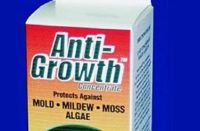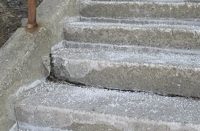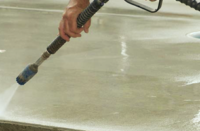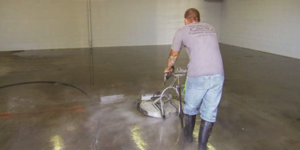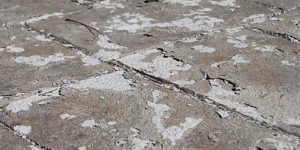
Decorative concrete is an incredibly versatile and durable choice for enhancing the aesthetic appeal of any outdoor area—from driveways and patios to walkways and beyond. Whether stamped, stained or polished, decorative concrete quickly adds character to an otherwise monotonous space.
However, to maintain these surfaces at their best, it’s essential to implement a maintenance routine that addresses the demands of changing seasons. Each new season brings along its own distinct challenges, with the potential to impact both the longevity and appearance of decorative concrete.

The Impact of Changing Seasons on Concrete
Concrete undergoes a dynamic interaction with the environment, making it susceptible to a variety of seasonal influences. One of the most significant factors is temperature fluctuations, which triggers expansion and contraction within concrete slabs and elements. During the scorching heat of summer, concrete absorbs and retains heat—causing it to expand. Conversely, in the bitter cold of winter, rapid cooling induces contraction, which can potentially lead to surface cracking and structural damage.

Moisture is another element that can have a profound impact on concrete, particularly during moisture-heavy seasons like spring and winter. In regions prone to heavy rain or snowfall, moisture infiltration poses a significant threat to the structural integrity of concrete. When the water permeates concrete pores and subsequently freezes during the winter months, it will expand and exert immense pressure on the concrete matrix—resulting in many internal micro-cracks. This freeze-thaw cycle can gradually compromise the strength and durability of concrete surfaces over time.

On the other hand, exposure to ultraviolet (UV) radiation from the sunlight can exacerbate the deterioration of concrete surfaces during summer or in high-heat regions. UV rays initiate a chemical reaction within the concrete matrix, causing color fading and surface degradation. This is often seen with decorative concrete applications, where vibrant colors and intricate patterns are often integral to the aesthetic appeal. Without adequate protection against UV radiation, decorative concrete may lose its luster and charm—ultimately diminishing the overall visual impact of architectural designs.
Efflorescence, which underscores the intricate interplay between moisture and soluble salts, is yet another common issue with concrete surfaces during certain seasons. As water migrates through concrete pores, it carries dissolved salts to the surface. As they evaporate, these salts crystallize and form unsightly white, powdery deposits known as efflorescence. This not only mars the visual appeal of decorative concrete, but signifies underlying, moisture-related issues that warrant maintenance.
Seasonal Care Tips for Decorative Concrete Applications
Seasonal maintenance is essential for preserving the beauty and integrity of decorative concrete structures. Throughout the year, environmental factors such as temperature fluctuations, moisture, freeze-thaw cycles and UV radiation can cause major issues like cracking, color fading, efflorescence and surface scaling. To mitigate these risks and ensure long-lasting performance, contractors should implement a maintenance routine that is specifically tailored to each season’s unique challenges.

Here is a four-step approach that will help to protect your investment, maintain its visual appeal and enhance the longevity of your decorative concrete structures:
1. Routine Inspections
It’s imperative to conduct thorough inspections at the start of each season to identify any signs of damage, such as cracks, chips, spalling and discoloration. This assessment should include horizontal surfaces like driveways and walkways, as well as vertical wall elements.
Early detection allows for timely intervention, which ultimately prevents minor issues from escalating into major problems down the road. For example, small cracks that are promptly addressed can be filled and sealed to avoid major structural damage. Regular inspections can also help to identify early signs of efflorescence, surface scaling or color fading.

2. Cleaning & Preparation
With cleaning and surface preparation, the first step is to remove all dirt, debris and stains from the concrete surface using appropriate cleaning agents. Pressure washing can be effective, but should be done carefully to avoid surface damage. Different types of decorative concrete materials may require specific cleaning methods, so always refer to the manufacturer’s recommendations.
Next, ensure the surface is thoroughly dry before applying any sealants or coatings. Moisture can hinder adhesion, causing treatments to bubble or peel. Surface preparation may involve light sanding or grinding to remove old sealant residues or smooth out imperfections. This enhances the adhesion and longevity of protective treatments, which is crucial before winter to protect against freeze-thaw cycles and
before summer to shield against UV degradation.

3. Coating Application
Another important seasonal maintenance practice is to apply high-quality sealers, coatings or water repellents, specifically designed for decorative concrete. These solutions enhance concrete durability and protect against moisture, UV exposure and chemical damage. For example, freeze-thaw cycles are a significant threat to concrete in colder climates. Using moisture-repellant sealers prevents water ingress, mitigating the risk of structural damage.
The vibrant colors and intricate patterns of decorative concrete are also prone to fading due to harsh sunlight and inclement weather. UV radiation accelerates the degradation of pigments and surface sealers, while rain, snow and temperature fluctuations wear down protective layers. Sealers act as a shield, helping to preserve the surface finish and durability.

4. Damage Repair
You should promptly address any cracks, chips or other surface imperfections. An example is surface scaling, which is marked by flaking or peeling of the concrete surface. It is a significant threat in urban environments with high traffic volumes and salt usage. Another common issue is efflorescence. This not only affects the visual impact of decorative concrete, but also indicates an underlying moisture problem that can compromise its structural integrity.
Routine cleaning and quick repairs, such as with the application of efflorescence inhibitors and protective coatings, help to prevent further deterioration of these concrete structures. This enhances the concrete’s resistance to moisture, scaling and abrasion—ultimately extending the lifespan of decorative concrete while maintaining its pristine appearance and durability.

Seasonal maintenance plays a key role in preserving the beauty and functionality of decorative concrete applications. By taking a proactive approach throughout the year, contractors can enhance the durability, longevity and aesthetic appeal of their projects through the changing seasons.
